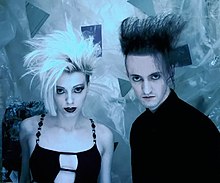Dark wave
[5][7] Common features include the use of chordophones such as electric and acoustic guitar, violin and piano, as well as electronic instruments such as synthesizer, sampler and drum machine.Attrition,[38] Die Form (France), Pink Industry (UK), Psyche (Canada), Kirlian Camera (Italy) and Clan of Xymox (Netherlands)[39] performed this music in the 1980s.Invasion,[8] Unlimited Systems, Moloko †, Maerchenbraut,[43][8] Cyan Revue,[18] Leningrad Sandwich,[18] Stimmen der Stille, Belfegore,[44] and Pink Turns Blue.[47][43] Ataraxia and the Frozen Autumn from Italy, and the French Corpus Delicti also evolved from this movement and became the leading artists of the west Romanesque dark wave scene.[64] Joshua Gunn, a professor of communication studies at Louisiana University, described the U.S. type of dark wave music as: ...an expansion of the rather limited gothic repertoire into electronica and, in a way, the US answer to the "ethereal" subgenre that developed in Europe (e.g. Dead Can Dance).[66][31] In the second half of the 1980s, former post-punk bands such as Dead Can Dance (Within the Realm of a Dying Sun, 1987[68]) and In the Nursery (Stormhorse, 1987[67]) released influential albums which essentially laid the foundations of the genre.[66][56] Other artists include Arcana,[31] Ataraxia,[66] Autumn Tears,[69] Camerata Mediolanense,[70] Dargaard,[71] Dark Sanctuary[31] Impressions of Winter,[72] Ophelia's Dream,[73] Les Secrets de Morphée,[56] Love Is Colder Than Death,[74] Stoa,[67] and WeltenBrand.

The Dark WaveNew wavepost-punkGuitarbass guitardrum machinesynthesizersamplerviolinpercussionCabaret noircold waveethereal wavegothic rockneoclassicalneofolkNeue Deutsche TodeskunstFranceGermanyminor keychordophonesneoclassical dark waveClan of XymoxBauhausJoy Divisionthe CureSiouxsie and the Bansheesthe Sisters of MercyAnne ClarkDepeche ModeGary Numanthe ChameleonsSoft CellKingston University, LondonCocteau TwinsDead Can DanceIn the NurseryOpera Multi Steelpost-industrial musicAttritionDie FormPink IndustryPsycheKirlian CameraMalaria!chansoncabaretProjekt RecordsNeue Deutsche WelleXmal DeutschlandPink Turns BlueThe Frozen AutumnGirls Under GlassDeine LakaienLove Like BloodLove Is Colder Than DeathDiary of Dreamsthe Eternal AfflictWolfsheimProject PitchforkAurora SutraAtaraxiaCorpus DelictiDas IchGoethes ErbenRelatives MenschseinEndraumIn My RosaryEngelsstaubSam RosenthalHyperium RecordsChandeenFaith and the MuseBlack Tape for a Blue GirlLove Spirals Downwardsethereal dark waveThis AscensionetherealBrendan PerryLisa Gerrardclassical musicsampleschamber orchestrasstringbrass instrumentsorchestral percussionWithin the Realm of a Dying SunStormhorseArcanaAutumn TearsCamerata MediolanenseDargaardDark SanctuaryWeltenBrandpost-punk revivalShe Wants Revengethe Soft MoonShe Past AwayDrab MajestyTwin TribesBoy HarsherWave-Gotik-TreffenLeipzigculturePentecostSAGE PublicationsHouston PressTrance to the SunAvant-funkAlternative danceArt punkColdwaveDance-rockDance-punkNew raveDeathrockElectroclashElectropunkGarage rock revivalIndie popJangle popMadchesterMinimal waveMinneapolis soundMod revivalNeo-psychedelia

